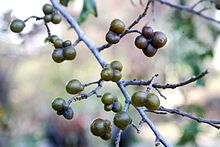Grewia occidentalis
Grewia occidentalis, the crossberry, is a species of deciduous tree, indigenous to Southern Africa.[1]
| Grewia occidentalis | |
|---|---|

| |

| |
| Fruits | |
| Scientific classification | |
| Kingdom: | Plantae |
| Clade: | Tracheophytes |
| Clade: | Angiosperms |
| Clade: | Eudicots |
| Clade: | Rosids |
| Order: | Malvales |
| Family: | Malvaceae |
| Genus: | Grewia |
| Species: | G. occidentalis
|
| Binomial name | |
| Grewia occidentalis | |
| Synonyms | |
| |

Description[edit]
A dense, attractive shrub or small tree with dark green leaves 3-10m high, sometimes scrambling. The common names are "crossberry" and "four-corner." Its simple leaves are shiny, deep green and slightly fleshy, about 5-7cm long with small rounded teeth. The sepals and petals form unusual double star-shaped flowers, purple, mauve, pink or rarely white, 1.5-3cm across. Flower time is summer, followed by four-lobed fruits (drupes). These shiny reddish-brown berry-like fruits remain on the tree after maturity and attract fruit-eating birds.
Distribution and Habitat[edit]
Grewia occidentalis occurs naturally across south-eastern Africa, where its range extends from Cape Town along the coast to Mozambique and inland to Zimbabwe.[4]
The native habitats of the plant are extremely varied, it is found in both the arid karoo of western South Africa and from the Highveld, and across the Afromontane forests of the Drakensberg range along the eastern coastline.[1]
Growing Grewia occidentalis[edit]
This decorative garden plant tolerates both light frost and drought. It also grows in both full sun or shade. The root system is not aggressive and can therefore be planted near buildings and paving, and it is very good at attracting butterflies and birds to the garden.[citation needed] The crossberry is best propagated from seed, although even then it can be erratic, as usually the seed needs to pass through the gut of a monkey before germination commences.[citation needed]
The berries are eaten locally, either fresh and raw, fermented with traditional beer, or used with goats milk to make berry yoghurt. [citation needed]
References[edit]
- ^ a b "Grewia occidentalis | PlantZAfrica.com". pza.sanbi.org. July 2008. Retrieved 13 December 2021.
- ^ Botanic Gardens Conservation International (BGCI).; IUCN SSC Global Tree Specialist Group (2019). "Grewia occidentalis". IUCN Red List of Threatened Species. 2019: e.T147141452A147141454. doi:10.2305/IUCN.UK.2019-2.RLTS.T147141452A147141454.en. Retrieved 18 November 2021.
- ^ "Grewia occidentalis L. | WFO (2021)". www.worldfloraonline.org. 2021. Retrieved 13 December 2021.
- ^ "Grewia occidentalis L. | Plants of the World Online". powo.science.kew.org. Retrieved 14 December 2021.
External links[edit]
![]() Media related to Grewia occidentalis at Wikimedia Commons
Media related to Grewia occidentalis at Wikimedia Commons
- Dressler, S.; Schmidt, M. & Zizka, G. (2014). "Grewia occidentalis". African plants – a Photo Guide. Frankfurt/Main: Forschungsinstitut Senckenberg.

